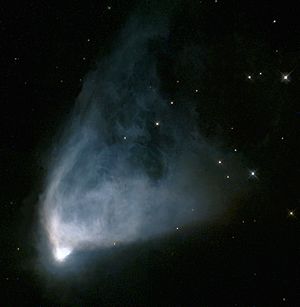Variable nebula facts for kids

A variable nebula is a special kind of reflection nebula that changes how bright it looks. These changes happen because the star hidden inside the nebula is also changing its brightness. Imagine a cosmic light show where the star is the main performer, and the nebula is its stage, lighting up differently as the star brightens and dims.
Contents
What is a Variable Nebula?
A variable nebula is a cloud of gas and dust in space. It doesn't make its own light. Instead, it shines by reflecting light from a nearby star. This is why it's called a reflection nebula. What makes it "variable" is that the star lighting it up isn't always the same brightness. When the star gets brighter, the nebula reflects more light and looks brighter too. When the star dims, the nebula also dims.
How Do They Change Brightness?
The changes in a variable nebula's brightness are directly linked to the star at its center. This star is usually very young and still forming. These young stars often have periods where they flare up, sending out more light. They also have periods where they dim down, sometimes because of dust clouds moving around them. As the star's light changes, the nebula around it responds, reflecting more or less light back to us.
The Role of the Central Star
The stars causing these changes are often called T Tauri stars. These are very young stars, usually less than 10 million years old. They are still gathering material from the cloud they were born in. T Tauri stars are known for being "unstable." This means their brightness can change a lot and quickly. They might have strong stellar winds, or clumps of gas and dust might orbit them, temporarily blocking their light. These actions directly affect how much light the nearby nebula receives and reflects.
Why Are They Important to Study?
Scientists study variable nebulae to learn more about how stars are born and how they grow. By watching how the nebula changes, astronomers can figure out what's happening with the young star inside. It's like having a giant screen that shows us the activity of a star that might otherwise be hidden by dust. These nebulae act like natural telescopes, showing us the star's behavior.
Famous Examples of Variable Nebulae
One of the most well-known variable nebulae is NGC 2261, also called Hubble's Variable Nebula. It's named after the famous astronomer Edwin Hubble, who studied it. This nebula changes its shape and brightness over just a few weeks or months. The star causing these changes is called R Monocerotis, or R Mon. R Mon is a very young, hot star that is still surrounded by a thick disk of gas and dust. As this dust moves and changes, it blocks different amounts of light from R Mon, making the nebula appear to change.
Another example is Hind's Variable Nebula, also known as NGC 1555. This nebula is lit by a star called T Tauri, which is the original star that gave the name to the entire class of T Tauri stars. Like NGC 2261, Hind's Variable Nebula also shows noticeable changes in brightness and shape over time, reflecting the activity of its central star.
Observing Variable Nebulae
Variable nebulae are usually observed using powerful telescopes. Because they are reflection nebulae, they often appear blue. This is because the tiny dust particles in the nebula scatter blue light more efficiently than red light, similar to why Earth's sky looks blue. Observing these changes helps astronomers understand the complex processes happening in star-forming regions of our galaxy.
See also
 In Spanish: Nebulosa variable para niños
In Spanish: Nebulosa variable para niños

